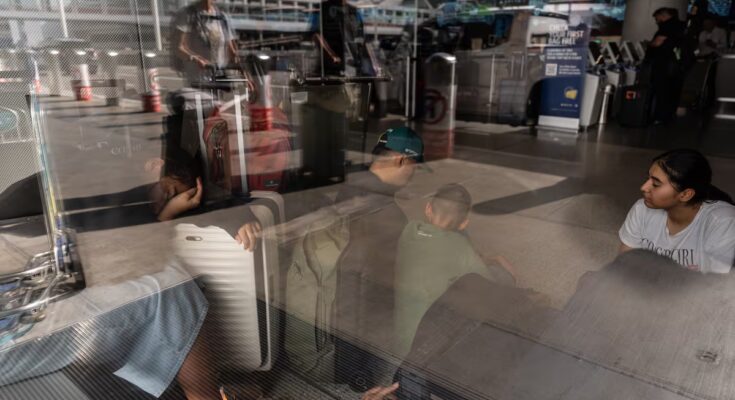The crisis at major US airports, triggered by restrictions imposed on air traffic following the government shutdown, will get worse before it starts to get better. Even as Congress moves closer to approving a deal to reopen the federal administration, officials warn that flights could be limited to “a trickle” before the arrival of the Thanksgiving season at the end of the month, one of the busiest times for travel.
The Federal Aviation Administration (FAA) issued an emergency order last Friday to progressively reduce the number of flights at 40 of the country’s major airports. The cuts started at 4%, rose to 6% this Tuesday and will increase to 10% next Friday, as a proactive measure to ensure traveler safety in the face of “system pressure” from reduced staffing at air traffic control facilities, which have already reached “critical levels” due to the government shutdown.
Transport Secretary Sean Duffy warned that flight cuts could reach 15% or more. The order states that airlines must cancel flights seven days before the travel date. The ordinance does not provide for a reduction in international flights.
Since the restrictions were announced last Friday, many of the country’s major airports have been the scene of chaos. Huge queues at check-in and security checks, flights delayed for several hours, hundreds of cancellations… On Monday alone, 2,422 canceled flights and 9,640 delays were recorded across the country, according to the specialized website FlightAware. By Tuesday afternoon, cancellations had already exceeded 1,200 and delays had reached 3,000. The airport with the most cancellations on Monday was Chicago O’Hare (where a winter storm hit), with more than 300. On Tuesday, the top spot was taken by LaGuardia, in New York. For reference, last year the daily average was 340 canceled flights across the country.
Air traffic controllers in the United States, employed by the federal agency FAA, have been working without pay since October 1, when the government shutdown began, which is already the longest in the country’s history. There are estimated to be around 14,000 drivers across the country. According to the FAA, between 20% and 40% of them at the 30 largest airports lost their jobs at some point during the closure. Some have started taking time off, citing stress or the need to look for other jobs.
Despite signs of legislative progress, the outlook remains uncertain. On Monday evening, the Senate approved a funding measure to reopen the government, which will now have to be ratified by the House of Representatives and subsequently signed by President Donald Trump. The deal is expected to be voted on in the House as early as Wednesday, and would restore essential services such as food assistance to millions of people and the payment of salaries to federal employees.
Speaking to reporters on Sunday, Duffy said the situation will “only get worse” as the government shutdown continues. “In the two weeks leading up to Thanksgiving, you will see air travel dwindle to a trickle,” the secretary said.
However, according to the official, even when the Administration reopens, flight cuts will remain in place until staffing levels in control towers have stabilized.
This staffing shortage is not new, but is now exacerbated by political stalemate. To become an air traffic controller in the United States, you must graduate from the FAA Academy and accumulate one to three years of work experience before becoming a certified professional. According to the agency, the average salary exceeds $160,000 per year by the third year of experience. Controllers work full time, and often overtime, in facilities that operate 24 hours a day and require shifts on weekends and holidays. Currently, a deficit of over 3,000 controllers is estimated. Earlier this year, the government tried to retain staff by offering bonuses to those close to retirement.
Federal employees affected by the government shutdown receive retroactive pay once the budget is approved, but even so, the National Air Traffic Controllers Association (NATCA) noted that after the 2019 shutdown, the second longest after the current one, retroactive payments have taken up to two months. Again, the number of daily departures by air traffic controllers has increased from an average of four to more than 20 since the shutdown began, Secretary Duffy told CNN.
For his part, President Trump lashed out at air traffic controllers Monday in a post on his Truth social media site, demanding they return to work immediately, threatening to reduce their pay and saying he would recommend a $10,000 per person bonus to those who didn’t take time off during the shutdown.



